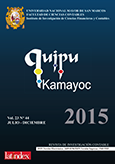FINANCIAL AUDIT AND RECOVERY OF CLIENTS’ SMES FROM THE BANCO DE CREDITO
DOI:
https://doi.org/10.15381/quipu.v23i44.11624Keywords:
Financial audit, placement of credits, client base Recovery, Small and Medium BusinessesAbstract
The thesis entitled “Financial Audit and its Impact on Credit Recovery of SME Clients from the Banco de Credito - Lambayeque Region” managed to verify the way that financial audit helps determine the presence of SME defaulting debtors from the Banco de Credi-to- Lambayeque Region, where the scientific research method was used. The thesis in the theoretical con-ceptual part, was developed by gathering information from different specialists, their contributions helped to consolidate the development of the variables: Finan-cial Audit and Credit Recovery of SMB customers- supported in its different indicators- and clarifying the contribution of the audit with a systematic and disciplined approach. The Fieldwork part used the survey technique- with the questionnaire instrument- that consisted on 20 questions, it allowed taking data from the selected sample; likewise the contrasting of hypothesis was carried out to arrive at conclusions and recommendations. Finally, the contribution of the research is to demonstrate how the Banco de Credito must use financial audit to control the placement of capital in small and medium enterprises.
Downloads
Downloads
Published
Issue
Section
License
Copyright (c) 2015 Karhy Cipriano Urtecho

This work is licensed under a Creative Commons Attribution-NonCommercial-ShareAlike 4.0 International License.
AUTHORS RETAIN THEIR RIGHTS:
a. Authors retain their trade mark rights and patent, and also on any process or procedure described in the article.
b. Authors retain their right to share, copy, distribute, perform and publicly communicate their article (eg, to place their article in an institutional repository or publish it in a book), with an acknowledgment of its initial publication in Quipukamayoc .
c. Authors retain theirs right to make a subsequent publication of their work, to use the article or any part thereof (eg a compilation of his papers, lecture notes, thesis, or a book), always indicating the source of publication (the originator of the work, journal, volume, number and date).






